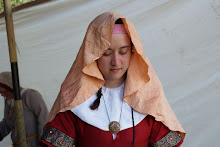Things really never change...fake gems, disappearing-reappearing ink, painting roses red, it has all been done before. Since this is a topic I love, and because there is so much information out there, I'm going to do this in parts. Today I'm going to focus on the Bolognese Manuscript, a 15th century book on dyeing, ink making, painting techniques, gilding, among other things. There are also many many recipes for making fake jewels. Here is a selection. I have to say, I haven't tried any of these recipes yet, but am planning to! So if anyone succesfully makes any of these, I'd love to hear your tips!
"To make pearls just like natural pearls.--Take pearls and pound them fine, and then put them into the before-mentioned water [2lbs of sal-ammoniac distilled]; then place the vessel containing the water with the pearls dissolved in it on the hot ashes to dry; and when the water is nearly evaporated, and the pearls remain at the botom of the vase, take it out, and add to it white of egg well beaten as if for vermilion, and knead up the pearls with white of egg like smooth paste. then take moulds and make the paste into pearls, and let them dry; pierce them, and let them boil in linseed oil. Then take out and rub them in bran, and afterwards on linen cloth. And if, instead of pearls, you put mother-of-pearl, it is good, and will make good pearls, &c." p. 553-4
"To imitate precious stones with crystal.--Take roche alum, alum zucarino, Roman vitriol, and "salis copertum", of each equal quantities, and put these ingredients into clear and strained ley, and dissolve them, and you may colour the crystal. For a sapphire, add azure; for an emerald, add verdigris; for a ruby, add vermilion; for a balas ruby, add verzino or "stupio"; for hyacinth, sky-blue and a little azure; for amethyst, some oricella; and so you may imitate all stones by adding different colours. Remember, however, that the crystal and the colours must be dissolved like colours and coagulated. Then boil them till they become like stones." p. 518
"To make sapphire, and to refine and colour it.--Take a crystal, or a transparent stone, and whichever you take heat it strongly and then quench it several times in cold water; then pound it, and take an equal quantity of sal alkali, and melt them together. Aftrwards put them into a furnace, and add a little zaffirro. And if you wish to have the colour green, add a little minium, and note, that some say that "callamita femina" makes a transparent red. Note also, that these stones are found upon Mount St. Bernard, and are good and perfect crystals, as if they were really mineral." p.524
To make amber (beads).--Take the whites of hen's eggs, and whip them with a sponge till they cease to froth; dd a little roche alum, colophony well powdered, and some cherry gum. Strain the mixture through a cloth, and put it into a flask well closed and luted, and set the flask in a jar full of water.; boil it for an hour, and then put it to cool in the open air, and dry it, and afterwards wrap it up in a linen cloth and bury it in dung for 3 days, and it will then be liquid, so that you may work it in your hands, and make beads and whatever you please. While you are modelling them, anoint your hands with common oil, pierce the beads, and let them dry, and they will be done." pp.515-6
"To Make a stucco for making imitation corals.--Take the white horn of a cow, break it, and soak it in strong ley for the space of a fortnight; then make it boil over the fire until it becomes soft like glue, and so that you can strain it through a cloth or a strainer; and when it is strained, take vermilion in the finest powder, and mix it up with the strained liquid, so as to be like dough, and make paternosters of it in moulds like pearls as before; then boil them in linseed oil, and let them dry. And if you scrape the horn with a glass, and then soak it in the manner above mentioned, it will soften so that you may strain it more easily, and do with it as before, and you will have fine and beautiful imitation corals" p. 544
"To make a window of goat-skin parchment which will appear to be real glass.--Take the skin of a id or a sheep or a goat, macerate it, remove the hair without lime, and scrape it very fine; then take a drachm of clean and clarified honey, mix it with 8 or 10 whites of eggs well beaten together with the honey in the same way as white of egg is beaten up for vermilion. Put the skin to soak in the white of egg and honey, squeeze it with your hand while in composition, and let it remain in soak for 2 or 3 hours at the most; Then take it out and stretch it well on a frame, and let it dry. Then paint upon it what you please, and let the colours dry well. Afterwards varnish it on one side, that is, on the side which the colours are, and dry it in moderate sunshine, and it will appear like glass" p. 492
Source: Merrifield, Mary P. "Medieval and Renaissance Treatises on the Arts of Painting: Original Texts with English Translations". Dover Publications, Inc: New York. 1967. ISBN: 0-486-40440-4
Subscribe to:
Post Comments (Atom)

No comments:
Post a Comment